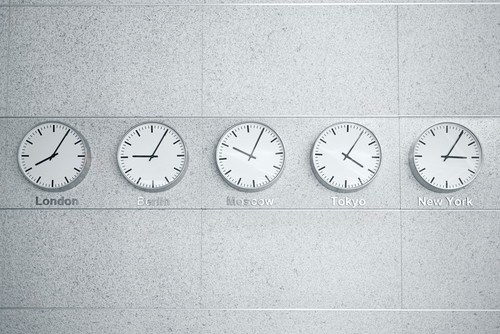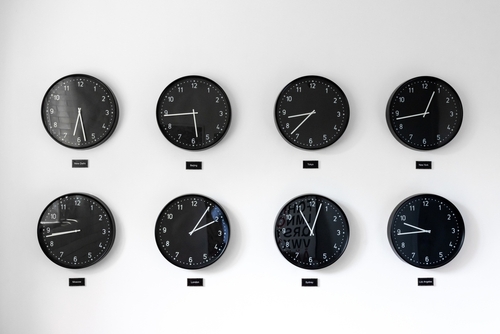Time zones may seem confusing, but they’re really how the world stays in sync across borders.
At Remitly, we know you’re connecting with family, scheduling meetings or face-to-face calls, and managing finances around the world, and we’re here to make it easier. This guide will help you understand time zones and navigate them with confidence. With our tips you’ll be able to communicate internationally without worrying about getting the timing right.
What are time zones and why do we have them?
Time zones are areas of the globe which share the same time. The world is broken up into 24 main time zones, each covering about one hour of the day. Within each time zone, people set their clocks to the same time in that zone.With different parts of the planet facing the sun at different times of day, if everyone on Earth used the same time, some places would have full sun at noon, while others would be in complete darkness. This doesn’t make a lot of sense.
Before time zones, every town kept its own local “solar time,” which meant clocks could be a little different from one place to the next. A city slightly east of your current location would be a few minutes ahead, for example. This didn’t matter too much before our world became so globalized, but it would create chaos nowadays—time zones make schedules, transportation, communication, and global coordination manageable and consistent.
History of time zones
Time zones started to become necessary in the 1800s, when trains and telegraphs began making long-distance travel and communication possible.
Suddenly, local solar time became confusing and dangerous. With stations operating on their own times, train arrivals were difficult to calculate, people and goods missed their connections, and accidents were too frequent.
Railroads across the UK and the US began implementing standard time zones—Greenwich Mean Time (GMT) in the UK, and four standard time zones (Eastern, Central, Mountain, and Pacific) in the US.
In 1884, the International Meridian Conference established the rules that became our modern time zones, with the Prime Meridian in Greenwich becoming the global reference, and the Earth being divided into 24 time zones.
How time zones are determined
Time zones are determined based on Earth’s location and its lines of longitude.
The system starts at the Prime Meridian in Greenwich, London, which is considered to be at 0° longitude. This time zone is called Greenwich Mean Time or, more officially, Coordinated Universal Time (UTC).
What are different time zones called?
There are 24 main time zones, each typically changing from the next by one hour. Some places use half-hour or even 45-minute offsets. But all time zones are measured by how many hours they are ahead or behind UTC. For example, New York is in UTC -5 and Tokyo is in UTC +9
So when it’s noon in London it’s 7 a.m. in New York and 9 p.m. in Tokyo, at least when Daylight Saving isn’t in force—we’ll come back to that in a bit.
Officially, UTC is the most common way to refer to time zones, but colloquially, many people refer to them based on a major city or region in that area, like Eastern Standard Time (EST, UTC -5) on the US East Coast, and India Standard Time (IST, UTC +5:30) in India.
The International Date Line
Since the Earth rotates eastward, time zones east of Greenwich are “ahead” of UTC, and time zones to the west are “behind.” The system of longitude runs from 0° at Greenwich up to 180° east and 180° west, “resetting” to zero at the International Date Line in the Pacific Ocean. Places east of that line are one calendar day ahead of places to the west.
The line isn’t perfectly straight—it bends around islands belonging to countries such as Kiribati and the US so you don’t have very small countries being in two different days at the same time.
Who decides what time zone a country is in?
Since time zones are a human invention, countries decide what time zone they want to be a part of. Most countries adjust their official times to what works best for their location and daily life. Larger countries, like Russia, Canada, and the US, may span multiple time zones.
However, not every country determines its time zone by what makes the most sense geographically. For example:
- Spain is near the Prime Meridian but has followed Central European Time (UTC +1) since 1940, except the Canary Islands.
- China spans five geographic time zones, but uses one official time zone (Beijing Time, UTC +8) for unity.
Because of this, time zones often aren’t straight lines. They bend around country borders and economic regions based on a country’s political or economic needs.

Understanding daylight saving time
Daylight Saving Time (DST) is when countries move their clocks forward one hour (“spring forward”) in the spring, and back one hour (“fall back”) in the fall, so people get more daylight in the evenings during summer.
Daylight started in the early 1900s as an energy-saving idea, but many countries kept it because people were enjoying longer warm-weather evenings outdoors.
Who observes daylight saving time?
These days many people, including politicians, debate DST’s usefulness. Not all countries use or observe it, and some places that did—like Russia, Argentina, and Turkey—have stopped:
- Most of North America, Europe, parts of the Middle East, and Oceania observe DST.
- Most of Asia, Africa, and parts of South America do not.
- Even within countries, observance can vary. In the US, for example, Hawaii and most of Arizona don’t observe DST, while the rest of the country does.
DST’s impact on international scheduling
The tricky part about DST is that countries don’t switch their clocks at the same time. The EU, for example, springs forward two weeks after and falls back one week before the US.
This means that the actual time difference between two places can change—for example, London and New York are four hours apart, not five, for a few weeks in March. That means your international meeting might actually be an hour earlier or later than you planned, so double-check your calendar.
There can also be time zone shifts between countries who do observe DST and countries that don’t. For example, the US and parts of Mexico may be at different times during DST, even though they’re in the same time zone. This is because Mexico is another country that, apart from some northern areas that border the US, has largely abolished DST.
Do I have to change my clock during DST?
Most modern devices, including smartphones, computers, and tablets, automatically adjust for DST according to their set region or time zone. This means you don’t usually have to make the change yourself, but you may need to with non-smart devices like traditional watches.
Practical tips for managing time zones
Managing all this might seem confusing if you’re living and working in multiple parts of the world, or moving around the globe a lot. So here are some tips to help you manage any potential problems with time zones.
For international communication
If you have to communicate with family, clients, or colleagues across the world, here are some ideas to help keep things simple:
- Use world clock apps or converters. If you often call the same places abroad, add them to your phone’s world clock or use an app like World Time Buddy to check times instantly.
- Agree on a common reference time. Many global teams set meetings at UTC time to avoid confusion, or each team member having to figure out exactly what time the meeting will be for them.
- Confirm time zones clearly. When you’re setting up a meeting with someone, double check if a decided time is in your time zone or theirs. This simple step can prevent missed calls and meetings.
For travel planning
When you cross time zones quickly, like when taking a long flight, your body’s internal clock may take several days to adjust to your current time. This is commonly known as jet lag, and can lead to fatigue, insomnia, irritability, and other difficulties.
Ease the transition by following these tips:
- Start adjusting your sleep schedule to your future time zone a few days before you travel. Apps like Timeshifter can help give you exact sleep and wake times.
- Get sunlight in your destination as soon as you can to help your body’s internal clock adjust.
- Avoid alcohol, as it can disrupt sleep.
- Use caffeine and exercise strategically in the morning to get you up.
- If you arrive at your destination during the day, try to stay awake until local bedtime.
- Keep your sleeping area comfortable—cool, dark, and quiet with earplugs and an eye mask can help you fall and stay asleep more easily.
- If you’re traveling for an important event like a conference or wedding, try to arrive a full day in advance, so your body can better adapt to the time change.
For sending money internationally
When sending money abroad, time zones can affect when friends, family, or colleagues actually receive it. Even if your bank processes a transfer right away, it might land outside business hours in the receiving country. Keep time zones in mind when deciding when exactly you plan on making a transfer.
Reputable international transfer services build these time zone differences into their delivery estimates, and offer delivery options with more flexible hours than banks. This way, your money arrives during the promised window, and there aren’t any unexpected delays.
By knowing how time zones work and using simple tools and strategies, you can stay on schedule, avoid confusion, and make the most of every international connection, no matter where in the world you or your loved ones are.
FAQ
Why do some countries have 30-minute or 45-minute time zones instead of whole hours?
Most time zones differ by whole hours, but some countries use half-hour or 45-minute offsets to match daylight to daily life better. For example, India uses UTC +5:30 so sunrise and sunset make more sense across the country. These decisions can also be political—for example, for one country to distinguish itself from another.
What’s the difference between GMT and UTC, and which one should I use?
GMT is based on the mean solar time at the Prime Meridian in Greenwich, London, while UTC is a modern time standard maintained with atomic clocks. For most everyday uses, the difference doesn’t matter, but for more precise fields like aviation and computing, UTC is the official standard.
Which countries are planning to stop using daylight saving time?
DST has become controversial, and many countries who previously used it have stopped completely, including Russia and Turkey. The EU has considered getting rid of it, but they haven’t reached a final decision. Certain states in countries that do use it, like Australia and the US, also don’t switch with the rest of the country.
How can I quickly figure out the best time to schedule phone calls with people in multiple time zones?
Choose a central reference time (like UTC) and use online tools like Google Calendar’s time zone feature. These tools can let you visualize overlapping business hours and quickly spot the best windows.
